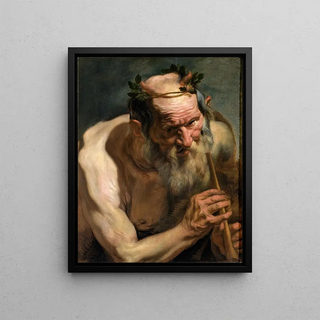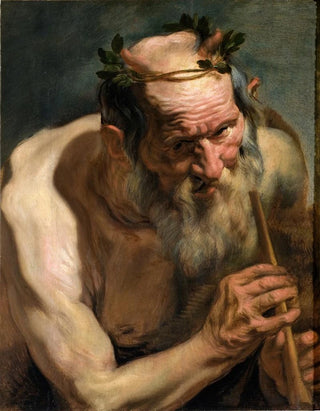Art print | Old satyr holding a flute - Jacob Jordaens


View from behind

Frame (optional)
In the vibrant universe of baroque art, "Old satyr holding a flute" by Jacob Jordaens stands out for its boldness and expressive depth. This artwork, imbued with vivid colors and rich textures, invites viewers to immerse themselves in a world where mythology and human nature intertwine. The satyr, an iconic figure of Greco-Roman mythology, embodies both the joy of living and the excesses of nature. Through this depiction, Jordaens does not merely portray a mythological character but explores universal themes of sensuality, celebration, and melancholy. The flute, a quintessential musical instrument, becomes the conduit of palpable emotion, transporting the observer to the heart of a vibrant and lively scene.
Style and uniqueness of the work
Jacob Jordaens' style is characterized by a realistic approach and meticulous attention to detail. In "Old satyr holding a flute," he manages to capture the very essence of his subject. The features of the satyr, both human and beastly, are rendered with precision that demonstrates the artist's virtuosity. Shadows and lights coexist harmoniously, creating a striking contrast that brings the composition to life. The colors, warm and vibrant, evoke a festive atmosphere while revealing a certain melancholy. The expression of the satyr, both joyful and pensive, invites reflection on the duality of human nature. Jordaens, through his skill in playing with emotions, transcends mere representation to offer a true aesthetic experience.
The artist and his influence
Jacob Jordaens, a major figure of 17th-century Flemish painting, established himself as an undisputed master of his era. A pupil of Rubens, he developed a distinctive style that combines realism and baroque elements, while incorporating folkloric and mythological motifs. His ability to depict scenes of everyday life, infused with symbolic meaning, profoundly influenced his

Matte finish

View from behind

Frame (optional)
In the vibrant universe of baroque art, "Old satyr holding a flute" by Jacob Jordaens stands out for its boldness and expressive depth. This artwork, imbued with vivid colors and rich textures, invites viewers to immerse themselves in a world where mythology and human nature intertwine. The satyr, an iconic figure of Greco-Roman mythology, embodies both the joy of living and the excesses of nature. Through this depiction, Jordaens does not merely portray a mythological character but explores universal themes of sensuality, celebration, and melancholy. The flute, a quintessential musical instrument, becomes the conduit of palpable emotion, transporting the observer to the heart of a vibrant and lively scene.
Style and uniqueness of the work
Jacob Jordaens' style is characterized by a realistic approach and meticulous attention to detail. In "Old satyr holding a flute," he manages to capture the very essence of his subject. The features of the satyr, both human and beastly, are rendered with precision that demonstrates the artist's virtuosity. Shadows and lights coexist harmoniously, creating a striking contrast that brings the composition to life. The colors, warm and vibrant, evoke a festive atmosphere while revealing a certain melancholy. The expression of the satyr, both joyful and pensive, invites reflection on the duality of human nature. Jordaens, through his skill in playing with emotions, transcends mere representation to offer a true aesthetic experience.
The artist and his influence
Jacob Jordaens, a major figure of 17th-century Flemish painting, established himself as an undisputed master of his era. A pupil of Rubens, he developed a distinctive style that combines realism and baroque elements, while incorporating folkloric and mythological motifs. His ability to depict scenes of everyday life, infused with symbolic meaning, profoundly influenced his






